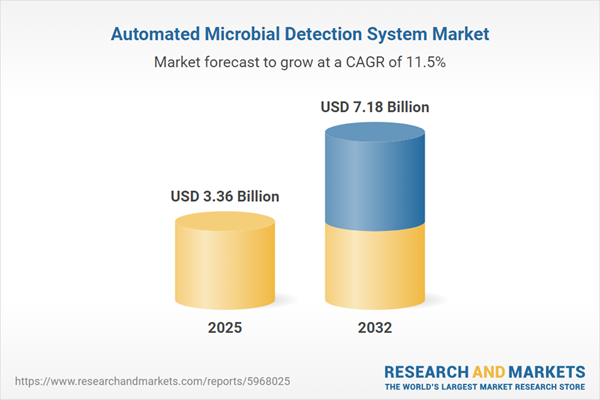Speak directly to the analyst to clarify any post sales queries you may have.
The Automated Microbial Detection System Market is experiencing robust transformation, shaped by advancing detection technologies, evolving regulations, and growing demand for efficient, compliant laboratory processes in core scientific sectors.
Market Snapshot: Automated Microbial Detection System Market Outlook
The global Automated Microbial Detection System Market advanced from USD 3.01 billion in 2024 to USD 3.36 billion in 2025, with a projected CAGR of 11.46% and an anticipated value of USD 7.18 billion by 2032. This sustained expansion reflects increasing requirements across healthcare, pharmaceuticals, food safety, and environmental monitoring for automated platforms that accelerate time-to-result, enhance analytical accuracy, and streamline operational workflows.
Scope & Segmentation of the Automated Microbial Detection System Market
This study comprehensively covers product landscapes, user demographics, key technologies, applications, and regional adoption patterns:
- Product Type: Consumables (culture media, kits, assay cartridges, reagents), Hardware (analyzers, detection instruments, isolation systems), Services (consulting, training, maintenance support), Software (data analysis, LIMS integration, remote monitoring)
- End User: Academic research institutes, clinical laboratories, environmental testing facilities, food and beverage processors, pharmaceutical and biotech organizations, water testing agencies
- Technology: Immunoassay-based, mass spectrometry-based, next-generation sequencing, PCR-based detection methods
- Application: Contamination monitoring, pathogen detection, quality control, research and development
- Region: Americas (with North and Latin American breakdowns), Europe, Middle East & Africa (EMEA), Asia-Pacific
- Key Players: Thermo Fisher Scientific, Merck KGaA, bioMérieux SA, Danaher Corporation, Sartorius AG, 3M, Charles River Laboratories, LuminUltra, Bio-Rad Laboratories, Emerson Electric
Key Takeaways for Senior Decision-Makers
- Technological advancements, such as high-throughput automation and cloud-based platforms, have redefined microbial detection, allowing for faster, more reproducible results.
- Regulatory shifts and heightened oversight continue to influence system validation standards, motivating vendors to prioritize investments in compliance and enhanced quality management systems.
- Emerging detection solutions, including next-generation sequencing with machine learning, are expanding pathogen identification and driving a need for data interoperability within laboratory ecosystems.
- Diversification of supply chain and supplier networks is a growing strategic priority to address operational risks associated with geopolitical and trade-related factors.
- Integration of consulting, training, and predictive maintenance within service offerings elevates client engagement, enabling laboratories to maximize uptime while maintaining analytical standards.
- Regional variations are pronounced, with established markets such as the Americas leading clinical adoption and Asia-Pacific regions experiencing rapid uptake due to government-led initiatives and streamlined procurement frameworks.
Tariff Impact on the Automated Microbial Detection System Supply Chain
The imposition of cumulative United States trade tariffs in 2025 recalibrated cost structures across the market. Manufacturers reliant on imported components experienced rising production expenses, prompting strategic shifts in supplier selection and inventory management. For consumables sourced internationally, tariff-related price adjustments influenced procurement negotiations and encouraged exploration of domestic manufacturing alternatives. These supply chain adaptations resulted in longer lead times, greater emphasis on cost transparency, and scrutiny of total cost of ownership by end users. Providers responded with bundled offerings and tiered pricing models to balance value and predictability for laboratory stakeholders.
Methodology & Data Sources
This report employs a blend of secondary and primary research. Inputs include regulatory filings, patent databases, scientific literature, and proprietary industry archives, validated by expert panel reviews. Primary insights were gained through confidential interviews with executive leadership, lab directors, and compliance experts, ensuring data reliability through triangulation and thematic aggregation.
Why This Report Matters for Market Leaders
- Guides strategic planning with actionable segmentation, market dynamics, and leading technology trends tailored for decision-makers in fast-evolving laboratory environments.
- Highlights supplier diversification and evolving regulatory requirements, supporting risk mitigation and operational resilience.
- Delivers competitive intelligence on key vendors, channel strategies, and emerging user needs for informed investment and partnership decisions.
Conclusion
The Automated Microbial Detection System Market represents an intersection of technological innovation, regulatory progress, and adaptive business strategies. Organizations that anticipate regulatory changes, embrace digital transformation, and build resilient supply chains will be best positioned to achieve sustained success in this evolving landscape.
Additional Product Information:
- Purchase of this report includes 1 year online access with quarterly updates.
- This report can be updated on request. Please contact our Customer Experience team using the Ask a Question widget on our website.
Table of Contents
3. Executive Summary
4. Market Overview
7. Cumulative Impact of Artificial Intelligence 2025
Companies Mentioned
The companies profiled in this Automated Microbial Detection System market report include:- Thermo Fisher Scientific Inc.
- Merck KGaA
- bioMérieux SA
- Danaher Corporation
- Sartorius AG
- 3M Company
- Charles River Laboratories International, Inc.
- LuminUltra Technologies Ltd.
- Bio-Rad Laboratories, Inc.
- Emerson Electric Co.
Table Information
| Report Attribute | Details |
|---|---|
| No. of Pages | 195 |
| Published | October 2025 |
| Forecast Period | 2025 - 2032 |
| Estimated Market Value ( USD | $ 3.36 Billion |
| Forecasted Market Value ( USD | $ 7.18 Billion |
| Compound Annual Growth Rate | 11.4% |
| Regions Covered | Global |
| No. of Companies Mentioned | 11 |









